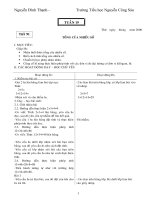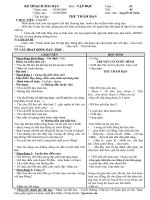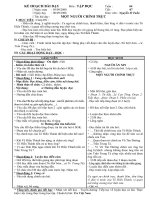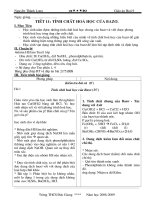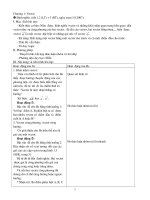Gián án Restrictive-Non-Restrictive Clauses
Bạn đang xem bản rút gọn của tài liệu. Xem và tải ngay bản đầy đủ của tài liệu tại đây (100.75 KB, 3 trang )
Restrictive-Non-Restrictive Clauses
Which vs. That in Restrictive and Nonrestrictive Clauses
If you’re puzzled about whether to us which or that, don’t panic! It’s really not too hard if you
remember these two types of clause: Nonrestrictive Clauses and Restrictive Clauses
A nonrestrictive clause can be eliminated from a sentence without losing the basic meaning of the
sentence. We should use the word which for these types of clauses. Nonrestrictive clauses will be set
apart from the rest of the sentence by dashes, commas, or parentheses as in these three examples:
The watch--which had been in her family for over sixty years--was stolen.
Jamie’s kite, which was blue and green, was flying high in the sky.
Tiffany’s graduation speech (which had caused a great deal of controversy at the
commencement ceremony) was printed in the local paper.
Try reading the sentences without the nonrestrictive clauses. Is the basic message of each sentence
the same?
A restrictive clause is a clause that is vital to the meaning of the sentence. Don’t even try to take
these clauses out of the sentence unless you really want to change the meaning! We use the word
that to mark these types of clauses. Because restrictive clauses are vital to sentences, they will not be
set apart with punctuation as shown in these examples. After you have read the sentences, go back
and circle the clauses (the part that begins with that). If you read what’s left of the sentences, you
can see that much of the meaning has been lost or changed.
The dog that is running down the street is mine.
The watch that my mother bought me for my birthday is my favorite watch!
The tests that I have studied for usually go really well.
PRACTICE EXERCISE
Now it’s your chance to practice the new grammar knowledge you’ve gained! Fill in the blanks
with either which or that depending on the sentence. Good luck!
1. Down by the mall there is a store ______reminds me of the store by Missy’s house.
2. We walked through the entire store ( ______ sold all kinds of kid’s toys) just to see Santa.
3. She saw the movie ______ had recently been released with a group of her friends.
4. India is a country ______ I would like to visit someday.
5. Frankenstein, _______ was written by Mary Shelley when she was only seventeen, touches upon
many issues that are relevant in our modern society.
6. When we were driving to John’s house, we saw the accident _____ had held up traffic on the
freeway.
7. I jogged every morning around the park ______ had the goat statue.
8. Maggie worried that she had forgotten to pay her phone bill _____ was due yesterday.
9. Bobby and Ryan were raising money for the new equipment, _______ included new balls and bats
as well as new uniforms.
10. We awaited the arrival of the books _____ we had ordered online.
Answers: 1. that, 2. which, 3. that, 4. that, 5. which, 6. that, 7. that, 8. that, 9. which, 10 that.
Now it’s your turn to write the sentences! How interesting can you make them? Write two
sentences using which in nonrestrictive clauses.
1. _____________________________________________________________________
2. _____________________________________________________________________
Now write two sentences using that in restrictive clauses.
1. _____________________________________________________________________
Page 1
Restrictive-Non-Restrictive Clauses
2. _____________________________________________________________________
Restrictive vs. Non-Restrictive Clauses
Relative clauses can be broken down into two types: (1) restrictive and (2) non-restrictive. A
restrictive clause provides information that is pertinent or essential to the meaning of the sentence.
A non-restrictive clause, also called a parenthetical or an appositive, contains information that is
extra. Information contained in a non-restrictive clause may be removed from the sentence
altogether without changing the overall meaning of the sentence. Because this information is not
crucial to the meaning of a sentence, it is set apart with commas, or, more emphatically, with dashes,
or parentheses.
Both kinds of clauses can be signaled by the use of wh word (which, when, where, and who). That is
used to signal a restrictive clause. Because a restrictive clause contributes to the basic meaning of the
sentence, it is not separated from the rest of the sentence with commas or other surrounding
punctuation.
The meaning of a sentence can be altered by whether a clause is punctuated so as to show that it is a
restrictive clause (giving crucial information) or a non-restrictive clause (giving extra information).
A summary table follows.
Restrictive Non-Restrictive (appositive/parenthetical)
a. begins with wh words or that may begin with wh words
b. presents highly relevant information gives “extra” information
c. is not separated from the sentence is separated by commas, dashes, or parentheses
Examples of non-restrictive clauses:
Bill Clinton, who was the former President, cheated on his wife.
Emily Brontë’s novel Wuthering Heights, which I read in my Victorian novels class this semester, is
a classic.
We know that these are non-restrictive clauses because the subjects’ names are given; therefore the
wh clauses are just giving extra information so it is appropriate that these clauses be set off by
commas.
Examples of restrictive clauses:
The woman whom I met at the baseball game was wearing my same shirt.
The on-screen kiss that I like the best is the one at the end of the movie Clueless.
We know that these are restrictive clauses partly because they are not set aside by commas, but also
because we need the information to know what is being talked about.
PRACTICE EXERCISE
Read the following sentences and put commas around the non-restrictive clauses. Put an N
after the sentences that are non-restrictive. Put an R after the sentences that contain a
restrictive clause.
Leave those sentences without internal punctuation. A few of the sentences could be either, but
the meaning would change.
1. Charles Dickens who was great writer in the late 19th Century is the author of Little Dorrit.
2. The piece of chocolate cake which probably has a million calories in it was delicious.
3. My favorite place to ski is Snow Basin in Utah which is one of the least crowded resorts.
4. The guy that my old roommate married is boring.
5. He reads and studies maps for fun which is no exaggeration.
6. I love the weather which has been so nice lately in Arizona.
Page 2
Restrictive-Non-Restrictive Clauses
7. My graduation from Arizona State University this August which I am extremely elated about has
been hard earned.
8. I am jealous of the guy in my neighborhood who drives a hot 1969 Chevy Camaro.
9. Methods of Teaching English which is my favorite class this semester meets on Tuesday nights.
10. I had the answer that made the most sense.
Answers: 1. N, 2. N, 3. N, 4. R, 5. N, 6. R, 7. N, 8. R, 9. N, 10. R
Decide which clauses or phrases are non-essential and which are essential and punctuate
accordingly.
1. Mr. John McCarthy who lives in Toronto is kind and intelligent.
2. The Mr. John McCarthy who lives in Toronto is kind, but the one who lives in Ottawa is cruel.
3. A clause which gives no necessary information is non-essential.
4. Psychiatrists who hate to talk to people are usually unsuccessful.
5. The second clause which was clearly non-essential was set off with commas.
6. All fraternity men who get caught growing marijuana will be expelled.
7. My great-grandfather Baldwin who spent most of his life in Alberta used to make his own
hickory furniture.
8. Priscilla was determined to marry no man who could not repair a wristwatch.
9. The person who draws the lucky number will receive a four-pound codfish.
10. The old gentleman frying tomatoes is the city constable.
11. “Silent Night,” now being sung by the North Bay Children’s Choir is my favorite hymn.
12. Perkins working overtime on Saturdays hoped to finish the job by September.
13. The question of thermodynamics in family life which so many scientists have ignored is fully
treated in one of John Black’s last books.
14. I often felt that Mrs. Twig was not fond of either of her children, but it was clearly the
daughter whom she hated.
15. Redwoods growing on the crest of mountains seldom attain a height of more than 50 feet.
16. Colonel Stone who had been 3 years in Africa began to grow homesick.
17. The Germans who lost the war suffered fewer casualties than did the victors.
18. My aunt who lives in Kingston will spend Christmas with me.
19. The old house which is situated on the hill has finally been sold.
20. J.B. Smith who lives only two blocks away owns a purple cow.
21. John Jiles who just inherited a million dollars is now celebrating in the pub.
22. Sally Thompson whom you will meet tonight is my third cousin.
23. People who know 40 languages are geniuses.
24. Please help all the students who fail this exam.
25. The author is Samuel Johnson who was born in England.
Page 3


